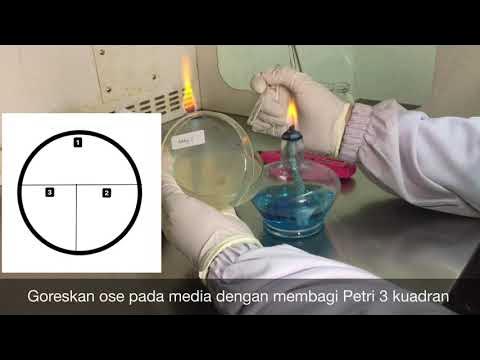Aseptic transfer from agar plate to slant
Summary
TLDRThis video demonstrates the process of inoculating an agar slant using a petri plate with isolated colonies. The steps include sterilizing the inoculating loop, carefully transferring bacteria from the petri dish to the agar slant in a fishtail motion, and ensuring proper handling and sterilization throughout the procedure. The video emphasizes safety measures, such as using the petri dish lid as a shield and flame-sterilizing the loop after each use, to maintain a contamination-free environment in microbiological work.
Takeaways
- 😀 Sterilize the inoculating loop by heating it in the flame until it glows orange.
- 😀 Always loosen the cap of the agar slant before beginning the inoculation process.
- 😀 Use the petri dish lid as a shield to protect the agar from contamination during handling.
- 😀 Touch the lid of the petri dish to a clean part of the agar to ensure it’s cool enough to handle.
- 😀 When picking a colony, choose one from the edge to minimize contamination risks.
- 😀 Hold the agar slant at an angle using your pinky to ensure easy manipulation during inoculation.
- 😀 Insert the sterilized loop into the base of the agar slant without touching the sides of the tube.
- 😀 Perform a fishtail motion with the loop across the slant surface to spread the inoculum.
- 😀 After inoculation, flame the loop again to sterilize it and prevent cross-contamination.
- 😀 Recap the agar slant after inoculation to protect it from external contaminants.
- 😀 Ensure all materials are sterilized and handled with care to maintain a contamination-free environment.
Q & A
What is the first step in inoculating an agar slant from a petri plate?
-The first step is to loosen the cap of the agar slant before beginning the inoculation process.
Why is it necessary to sterilize the inoculating loop?
-Sterilizing the inoculating loop ensures that no unwanted bacteria or microorganisms are introduced to the agar slant, preventing contamination.
How do you sterilize the inoculating loop?
-To sterilize the inoculating loop, you heat it from the base to the tip using the hottest part of the flame until it glows orange.
What is the role of the petri plate lid during the inoculation process?
-The petri plate lid acts as a shield to protect the culture and prevent contamination while you're working with the agar plate.
How do you pick up a colony from the petri plate?
-To pick up a colony, you gently touch the edge of the colony with the sterilized loop, making sure to only pick a small amount of bacteria.
Why is it important to allow the inoculating loop to cool before touching the petri plate?
-Allowing the loop to cool prevents the heat from damaging or killing the bacteria you intend to pick up from the petri plate.
What motion is used when inoculating the agar slant with the loop?
-A fishtail motion is used when inoculating the agar slant. This ensures that the bacteria are evenly distributed along the slant surface.
What is the correct way to hold the agar slant during inoculation?
-The agar slant should be held at a slanted angle towards you, making it easier to inoculate the surface without contamination.
What should you do immediately after inoculating the agar slant?
-After inoculating the agar slant, you should flame the loop again and then recap the agar slant to prevent contamination.
What should you be cautious about when inserting the loop into the agar slant?
-You should be cautious not to touch the sides of the agar slant with the loop to avoid introducing contaminants.
Outlines

This section is available to paid users only. Please upgrade to access this part.
Upgrade NowMindmap

This section is available to paid users only. Please upgrade to access this part.
Upgrade NowKeywords

This section is available to paid users only. Please upgrade to access this part.
Upgrade NowHighlights

This section is available to paid users only. Please upgrade to access this part.
Upgrade NowTranscripts

This section is available to paid users only. Please upgrade to access this part.
Upgrade NowBrowse More Related Video

Inoculation Methods

Session 2 Culturing Bacteria Part 1 Plating on to agar plates

Lab technique microbiology: Streak plate method

PRAK. KE-1C. ISOLASI AZOTOBACTER - BIOTEK PERTANIAN (Lab. Biotan Faperta Unpad)

Serial dilutions and pour plate technique

Isolasi bakteri dengan teknik pengenceran dan penanaman secara spread plate
5.0 / 5 (0 votes)